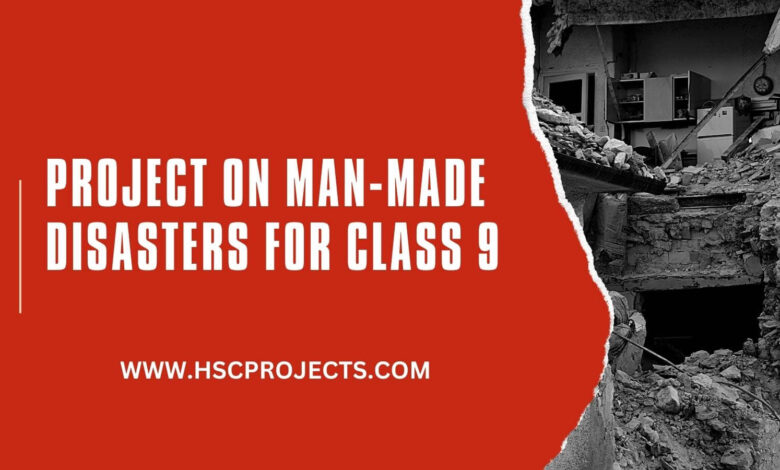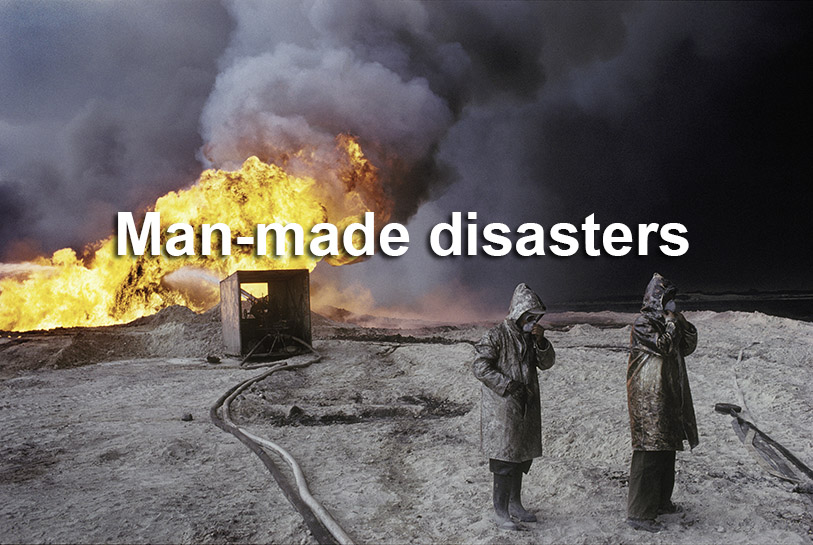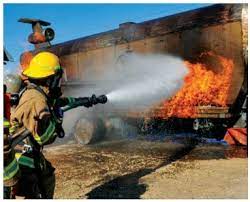
Project On Man-Made Disasters For Class 9
Acknowledgment
I want to sincerely thank my teacher, Mr./Ms. [insert name], for giving me the chance to work on this project and for assisting me all the way through it.
I also want to express my gratitude to my parents for their consistent support and encouragement, which kept me inspired and on task.
In addition, I appreciate [insert name of group/person] for giving me the knowledge and tools I needed to conduct my research successfully.
I also want to express my gratitude to my classmates for their insightful criticism and recommendations, which helped me raise the calibre of my work.
Finally, I want to thank [insert name of person/people] for their assistance with editing and proofreading my project.
This project would not have been possible without the help and direction of every one of these people.
Introduction

Events that result in serious harm to human life, property, and the environment are referred to as man-made catastrophes. These catastrophes can occur in a variety of ways, including industrial accidents, environmental contamination, vehicle accidents, and terrorist attacks, among others.
Man-made disasters can have deadly and pervasive effects. They can result in significant human casualties, harm, community uprooting, as well as severe economic and environmental damage. Man-made catastrophes frequently result in the disruption of vital services, such as the supply of food, water, and energy, which can have long-term effects on the people affected.
Man-made Disaster Causes
A number of things, such as human error, negligence, a lack of safety precautions, and deliberate acts of violence, contribute to man-made disasters. Common causes of man-made disasters include the following:
Human Error: Human error is a major factor in many man-made disasters, including mistakes committed when operating machines, poor communication, and poor judgement. For instance, an operator misread the status of the facility, which led to the nuclear catastrophe at Three Mile Island.
Negligence: Failure to take proper precautions or to act with care might result in disasters that are caused by humans. For instance, the negligence of the building owner and officials who let the facility to function despite safety violations led to the collapse of the Rana Plaza building in Bangladesh in 2013 and the deaths of over 1,100 people.
Lack of Safety Measures: On occasion, human error leads to tragedies since there aren’t any safety precautions in place or the standards aren’t high enough. For instance, the lack of fire protection precautions in the building contributed to the Grenfell Tower disaster in London in 2017.
Intentional Acts: Man-made disasters can also be brought on by deliberate acts of violence, such as terrorism, sabotage, or hostilities. Over 3,000 people were killed as a result of the planned terrorist attacks on September 11, 2001, which took place in the United States.
In order to prevent and lessen the effects of man-made disasters, it is crucial to understand their causes. We can take action to address these issues and stop further occurrences of these calamities by determining their underlying causes.
Disaster Prevention Measures
It takes a team effort from individuals, groups, and governments to stop man-made disasters. The following safety measures can assist prevent or lessen the effects of man-made disasters:
Risk assessment: A thorough risk assessment can be used to find possible threats and weak points and create countermeasures.
Safety Measures: By putting safety measures into place, such as routine equipment maintenance, worker safety training, and the enforcement of safety standards, accidents can be avoided and the effects of disasters can be lessened.
Emergency Response Planning: Planning an emergency response strategy can help save lives and limit the damage by outlining the steps to be performed in the case of a disaster. The strategy should cover how to evacuate, how to communicate, and how to provide shelter and medical care.
Community Preparedness: By creating resilient communities via education, training, and community involvement, disaster effects may be lessened. This entails keeping emergency supplies on hand, practicing drills, and making sure that basic amenities like a water and power supply are available.
Environmental Responsibility: Encouraging environmental responsibility can help avoid man-made disasters like oil spills and chemical leaks by minimising waste and pollution.
These steps can help us lower the likelihood of man-made disasters while also ensuring the security and well-being of both individuals and communities.
Historical Examples Of Man-made Disasters
Man-made disasters have harmed people and the environment significantly throughout history. Here are a few significant historical man-made disaster examples:
Chornobyl Nuclear Disaster: In 1986, a catastrophic radioactive material discharge at the Chernobyl nuclear power station in Ukraine resulted in the evacuation of over 100,000 people as well as long-term health and environmental effects.
Bhopal Gas Tragedy: The Bhopal Gas Tragedy occurred in 1984 when a Union Carbide pesticide facility in Bhopal, India, had a gas leak that resulted in the deaths of over 3,000 people, the exposure of others to dangerous chemicals, and environmental devastation.
Exxon Valdez Oil Spill: In 1989, an oil ship named Exxon Valdez capsized in Alaska, resulting in a major oil spill that wiped off wildlife and destroyed the environment.
Deepwater Horizon Oil Spill: In 2010, a large oil spill in the Gulf of Mexico as a result of an explosion at the Deepwater Horizon oil rig resulted in long-term environmental harm and financial losses.
Triangle Shirtwaist Factory Fire: A fire at the Triangle Shirtwaist factory in New York City in 1911 claimed the lives of 146 people and resulted in the improvement of labour laws and workplace safety standards.
These historical instances demonstrate the terrible effects of man-made disasters and the requirement for precautions and responsible decision-making. We can prevent future occurrences of these tragedies by comprehending their causes and effects.
Measures To Reduce The Impact Of Man-made Disasters

Actions done to lessen the effects of disasters and stop them from getting worse are known as mitigation strategies. Here are some precautions you can take in case of man-made disasters:
Early Warning devices: These devices can warn individuals of imminent disasters so they can get ready and flee. These systems may include alerts delivered by TV, phones, and other lines of communication.
Hazard mapping: Identifying high-risk areas and creating measures to lessen the effects of disasters can both be accomplished by mapping an area’s hazards and vulnerabilities.
Disaster Response Training: First aid and emergency professionals should receive training in disaster response to increase their efficiency and save lives. This includes instruction in first aid, evacuation techniques, and search and rescue techniques.
Infrastructure Protection: Infrastructure protection may stop disasters from getting worse and guarantee that vital services are available both during and after a disaster by safeguarding vital infrastructure including power plants, water treatment facilities, and communication networks.
Environmental Protection: By putting policies and regulations in place to safeguard the environment, disasters caused by humans—like oil spills and chemical leaks—can be avoided altogether.
Strategies for Risk Reduction: Implementing actions like modifying structures to withstand earthquakes or floods, evacuating populations from high-risk locations, or enforcing zoning regulations that prohibit construction in hazardous places are all examples of ways to reduce the risks associated with man-made disasters.
We can lessen the effects of man-made disasters and safeguard local communities and the ecosystem by putting these mitigation measures into place.
Man-made Disaster Causes Include
Human misdeeds, blunders, or ignorance that injure both people and the environment are what lead to man-made disasters. Here are some typical human-caused disaster causes:
Human Error: Human error, such as mistakes committed when operating machinery or poor worker communication, is to blame for many man-made disasters.
Technological Failure: Failure of technology or apparatus can result in catastrophes like nuclear meltdowns, oil spills, and chemical leaks.
Poor Planning and Design: Disasters including building collapses, bridge collapses, and dam breaches can result from poor planning and design.
Lack of Regulation: Regulating and enforcing laws properly can prevent disasters like workplace accidents and pollution problems.
Human Conflict: Man-made disasters, including bombs, chemical assaults, and other violent acts, can come from wars, terrorism, and other types of human strife.
Environmental Degradation: Deforestation, overfishing, and climate change are examples of environmental degradation that can result in man-made disasters including landslides, floods, and droughts.
We can take action to avert man-made disasters and lessen their effects on society and the environment by understanding their causes. To prevent harm, this entails putting safety measures into place, encouraging wise decision-making, and upholding rules and laws.
Conclusion
Natural resources, as well as people, property, and the environment, are all negatively impacted by man-made disasters. These catastrophes are frequently avoidable with careful planning, risk assessment, and mitigation strategies.
It is crucial for people, groups, and governments to assume accountability for averting man-made disasters and lessening their effects. This entails raising public knowledge of potential dangers and putting preventative measures into place, such as early warning systems, training for disaster response, and infrastructure protection.
Although we cannot completely rule out the possibility of man-made disasters, we can take measures to prevent them from happening and lessen the impact when they do. We can build a safer, more resilient future for ourselves and future generations by cooperating and taking action to safeguard ourselves and our environment.
Bibliography
United Nations Office for Disaster Risk Reduction. (2019). Global Assessment Report on Disaster Risk Reduction 2019. Retrieved from https://www.undrr.org/publication/gar2019
National Geographic Society. (2021). Man-made Disasters. Retrieved from https://www.nationalgeographic.org/encyclopedia/man-made-disasters/
World Health Organization. (2020). Chemical Emergencies. Retrieved from https://www.who.int/news-room/q-a-detail/chemical-emergencies
United States Environmental Protection Agency. (2022). Environmental Emergencies. Retrieved from https://www.epa.gov/environmental-emergencies
National Oceanic and Atmospheric Administration. (2021). Natural Hazards. Retrieved from https://www.noaa.gov/education/resource-collections/weather-atmosphere/natural-hazards
Certificate
This is to certify that I, [Your Name], a student of Class 9 at [Your School Name], have successfully completed the project on “Man-Made Disasters. ” I am thrilled to have had the opportunity to explore and understand the causes, impacts, and preventive measures related to man-made disasters.
I would like to express my heartfelt gratitude to my teacher, Mr. /Ms. [Teacher’s Name], for guiding and supporting me throughout this project. Their valuable feedback and encouragement have been instrumental in the successful completion of this project.
I am also deeply grateful to my parents for their unwavering support and motivation. Their belief in my abilities and constant encouragement kept me inspired and focused on the project.
Furthermore, I extend my appreciation to [insert name of group/person] for providing me with the necessary knowledge and resources to conduct thorough research for this project.
I would also like to thank my classmates for their insightful criticism and recommendations during the research and writing process. Their input helped me improve the quality of my work.
Lastly, I want to express my gratitude to [insert name of person/people] for their assistance in editing and proofreading my project. Their help ensured that the project was well-presented and error-free.
This project has been a valuable learning experience for me, and I hope that the information presented in it will raise awareness about man-made disasters and the importance of taking preventive measures to protect lives, property, and the environment.
Date: [Date]Place: [Your City] [Your Signature](Your Name)
In order to download the PDF, You must follow on Youtube. Once done, Click on Submit
Follow On YoutubeSubscribed? Click on Confirm
Download Project On Man-Made Disasters For Class 9 PDF






